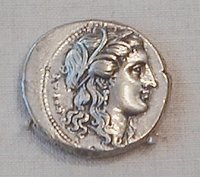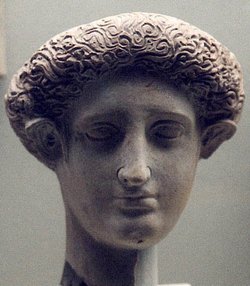Persephone
|
|
| Greek deities series |
|---|
| Primordial deities |
| Titans and Olympians |
| Aquatic deities |
| Personified concepts |
| Other deities |
| Chthonic deities |
| Hades and Persephone, |
| Gaia, Demeter, Hecate, |
| Iacchus, Trophonius, |
| Triptolemus, Erinyes |
| Heroes and the Dead |
In Greek mythology, Persephone ("per-SE-fo-neh") was the queen of the Underworld, the Kore or young maiden, and the daughter of Demeter.
Persephone ("she who destroys the light") is her name in the Ionic Greek of epic literature. In other dialects she was known under various other names: Persephassa, Persephatta, or simply Kore. The Romans first heard of her from the Aeolian and Dorian cities of Magna Graecia, who used the dialectal variant Proserpina.
Hence, in Roman mythology she was called Proserpina, and as a revived Roman Proserpina she became an emblematic figure of the Renaissance.
| Contents |
Overview
The figure of Persephone is a well-known one today. Her story has great emotional power: an innocent maiden; a mother's grief at the abduction and the return of her daughter. It is also cited frequently as a paradigm of myths that explain natural processes, with the descent and return of the goddess bringing about the change of seasons.
But the Greeks knew another face of Persephone as well. She was also the terrible Queen of the dead, whose name was not safe to speak aloud, who was named simply "The Maiden". Her central myth, for all of its emotional familiarity, was also the back-story of the secret initiatory mystery rites of regeneration at Eleusis, which promised immortality to their awe-struck participants—an immortality in her world beneath the soil, feasting with the heroes beneath her dread gaze (Kerenyi 1960, 1967).
The Abduction Myth
In the Olympian pantheon, Persephone is given a father: according to Hesiod's Theogony, Persephone was the daughter produced by the union of Zeus and Demeter. "And he [Zeus] came to the bed of bountiful Demeter, who bore white-armed Persephone, stolen by Hades from her mother's side".
Unlike every other offspring of an Olympian pairing, however, Persephone has no stable position at Olympus. Persephone used to live far away from the other gods. She used to take care of nature by planting seeds and nurturing plants. Persephone lived a peaceful life before she became the goddess of the underworld when Hades abducted her and brought her into the underworld. She was innocently picking flowers with some nymphs (or Leucippe, or Oceanids) in a field in Enna when he came, bursting up through a cleft in the earth; the nymphs were changed by Demeter into the Sirens for not having interfered. Life came to a standstill as the depressed Demeter (goddess of the Earth) searched for her lost daughter. Helios, the sun, who sees everything, eventually told her what had happened.
Finally, Zeus could not put up with the dying earth and forced Hades to return Persephone. But before she was released to Hermes, who had been sent to retrieve her, Hades tricked her into eating six pomegranate seeds, which forced her to return six months out of each year. In some versions, Ascalaphus informed the other gods that Persephone had eaten the pomegranate seeds. When Demeter and her daughter were together, the Earth flourished with vegetation, but for six months each year, when Persephone returned to the underworld, the earth once again became a barren realm. In an alternate version, Hecate rescued Persephone.
This myth can also be interpreted as an allegory of ancient Greek marriage rituals. The Greeks felt that marriage was a sort of abduction of the bride by the groom from the bride's family, and this myth may have explained the origins of the marriage ritual. The more popular etiological explanation of the seasons may have been a later interpretation.
Persephone, as Queen of Hades, only showed mercy once, because the music of Orpheus was so hauntingly sad. She allowed Orpheus to bring his wife Eurydice back to the land of the living as long as she walked behind him and he never tried to look at her face until they reached the surface. Orpheus agreed but failed, looking back at the very end to make sure his wife was following, and lost Eurydice forever.

Persephone also figures in the story of Adonis, the Syrian consort of Aphrodite. When Adonis was born, Aphrodite took him under her wing, seducing him with the help of Helene, her friend, and was entranced by his unearthly beauty. She gave him to Persephone to watch over, but Persephone was also amazed at his beauty and refused to give him back. The argument between the two goddesses was settled either by Zeus or Calliope, with Adonis spending four months with Aphrodite, four months with Persephone and four months of the years with whomever he chose. He always chose Aphrodite because Persephone was the cold, unfeeling goddess of the underworld.
When Hades pursued a nymph named Mintho, Persephone turned her into a mint plant.
Persephone was the object of Pirithous' affections. Pirithous and Theseus, his friend, pledged to marry daughters of Zeus. Theseus chose Helen and together they kidnapped her and decided to hold onto her until she was old enough to marry. Pirithous chose Persephone. They left Helen with Theseus' mother, Aethra, and travelled to the underworld, domain of Persephone and her husband, Hades. Hades pretended to offer them hospitality and set a feast; as soon as the pair sat down, snakes coiled around their feet and held them there.
Persephone and her mother Demeter were often referred to as aspects of the same goddess, and were called "the Demeters" or simply "the goddesses." The story of Persephone's abduction was part of the initiation rites in the Eleusinian Mysteries.
Modern Scholarship on Persephone
Persephone Before the Greeks?
Many modern scholars have argued that Persephone's cult was a continuation of Neolithic or Minoan goddess-worship. Among classicists, this thesis has been argued by Gunther Zuntz (Zuntz 1973) and cautiously included by Walter Burkert in his definitive Greek Religion.
More daringly, the mythologist Karl Kerenyi has identified Persephone with the nameless "mistress of the labyrinth" at Knossos.
On the other hand, the hypothesis of a universal cult of the Earth Mother has come under increasing criticism in recent years. For more on both sides of the controversy, see Mother Goddess.
Life-Death-Rebirth
Inspired by James Frazer, Jane Ellen Harrison and modern mythologers, some scholars have labeled Persephone a life-death-rebirth deity.
Consorts/Children
- Unknown father (Some say Zeus)
- Iacchus -consort
- Persephone and Hades are notable as the only divine couple who did not produce children, besides Aphrodite and Hephaestus.
The 1911 Britannica's account of the myth
"As she was gathering flowers with her playmates in a meadow, the earth opened and Pluto, god of the dead, appeared and carried her off to be his queen in the world below. ... Torch in hand, her sorrowing mother sought her through the wide world, and finding her not she forbade the earth to put forth its increase. So all that year not a blade of corn grew on the earth, and men would have died of hunger if Zeus had not persuaded Pluto to let Proserpine go. But before he let her go Pluto made her eat the seed of a pomegranate, and thus she could not stay away from him for ever. So it was arranged that she should spend two-thirds (according to later authors, one-half) of every year with her mother and the heavenly gods, and should pass the rest of the year with Pluto beneath the earth. ... As wife of Pluto, she sent spectres, ruled the ghosts, and carried into effect the curses of men."
See also
References
- Karl Kerenyi (Eleusis: Archetypal Image of Mother and Daughter, 1960, in English 1967)
- Günter Zuntz, Persephone: Three Essays on Religion and Thought in Magna Graecia, 1973
- Walter Burkert, Greek Religion 1985
- Lewis Richard Farnell. The Cults of the Greek States, Volume 3 (1906) (Chapters on: Demeter and Kore-Persephone; Cult-Monuments of Demeter-Kore; Ideal Types of Demeter-Kore).da:Persefone
de:Persephone (Mythologie) fr:Perséphone it:Persefone (mitologia) ja:ペルセポネ nl:Persephone sv:Persefone pl:Persefona pt:Perséfone

